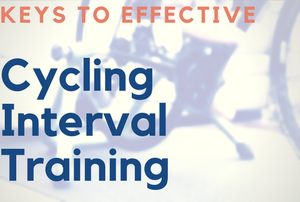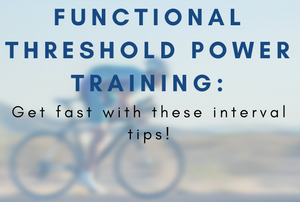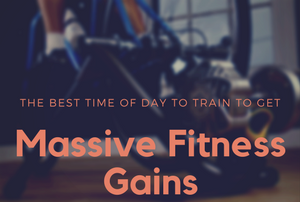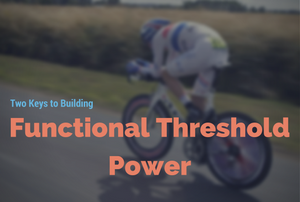
Many training plans allude to “high intensity interval training” in their descriptions. The big question is always “what is interval training and how do I know it'll work for me?”
Sometimes, interval training is well balanced and effective. More often than not, though, it is overly difficult and non-specific. You see, designing an interval training program is an art as much as a science. You have to consider the ultimate physiological goal and figure out how to best get there. What durations work the best? What intensities work the best? How many repetitions are optimal?
These questions are all part of the keys to effective interval training. Click through the jump and I'll break down the 3 keys to building your own interval program. At the end, I'll even give you some tips that I use to build interval programs for my athletes so you can build your own interval training programs.
Continue reading “Keys to Effective Cycling Interval Training”

Functional threshold power intervals are the staple of any build program. While VO2 max is the genetic parameter that determines your body's upper limit of aerobic fitness, functional threshold is the parameter that determines how much (or what percentage) you can use.
How do you build Functional Threshold Power?
Functional Threshold Power really is what most people try to improve in a training program. While efficiency plays a role and VO2 max capacity is important, FTP is the big comparison number. Well, W/Kg really is the king, but FTP is the most well known and compared in amateur circles.
That said, how do we go about improving FTP? Well, you have to have the VO2 max ceiling first. Once you have that, the goal is to force your body to work right at or just above FTP to create endurance adaptations. You can do that in a number of different ways, each with their own outcomes.
Continue reading “Functional Threshold Power Training Intervals”

Most people don't think about what time of day they train and how that can affect their fitness gains. In fact, a lot of people simply look at their training plan, jump on their bike and go when they have some free time. And that's fine if you're looking to make some improvements from baseline. But what if you're looking for that extra few percentage points to help get you onto the podium? What if you're pushing for that big century goal and you need to shave off a few more minutes?
If you're a pro, you plan life around training, but if you're a Joe, you plan training around life. When you have to plan training around life, time of day can make a big difference in the fitness gains you see.
On this episode of the Tailwind Coaching Podcast, I'll explain to you how the time of day can affect your training. We'll go over how to determine the best time of day for your body to train and what you gain by figuring that out. You'll also get a few tips and tricks to help you minimize the impact of training off your “peak” time of day.
So if you're ready to biohack your training time and get bigger fitness gains out of the hours you spend on the bike, click through the jump and listen to this episode of the Tailwind Coaching Podcast. Don't forget to share with your friends and rate the podcast on iTunes!
Continue reading “The Best Time Of Day To Train For Massive Fitness Gains”

As a cyclist finishes their base training, it's important to evaluate how strong your aerobic base truly is. By using a metric called “aerobic decoupling” you can quickly and easily determine if your base work was effective and if you're ready to progress into harder high-intensity interval training. But before you can evaluate your aerobic fitness, you need to learn what aerobic decoupling is and how to use it effectively.
What is aerobic decoupling and why do we care about it?
If you're training with power, aerobic decoupling is a key measurement to evaluate as you perform base training. Aerobic decoupling is a numerical measurement of aerobic efficiency and endurance. It's representative of your body's ability to process oxygen and produce energy (as detailed in Biohacking Energy Systems) and is a marker of overall aerobic fitness.
Before you can appreciate the value of aerobic decoupling, here's a refresher about how your body produces aerobic energy and the concept of heart rate drift.
To produce energy, your body takes in oxygen through the lungs and passes it to working muscles via the blood stream. Oxygen and a fuel (fat, protein or sugars) are processed in the mitochondria to create Adenosine Triphosphate (ATP). ATP is the actual energy molecule that allows your muscles to contract and create pedaling force. Constant demands on the aerobic energy system can create a phenomenon known as heart rate drift.
Click through the jump to read the show notes for episode 78 of the Tailwind Coaching Podcast:
Podcast: Play in new window | Download (Duration: 46:53 — 33.6MB)
Subscribe:

Building functional threshold power is one of the biggest objectives of most competitive cyclists. Cyclists everywhere like to brag about how many watts they put out at threshold. Coffee shop talk is dominated by phrases like “watts per kilogram” and “threshold intervals” in the pursuit of more cycling power. Interval training programs are based on the concept of how much power you can put out at threshold.
I'm telling you that functional threshold power is indeed one of the biggest goalposts we measure fitness by. The way we've consistently tried to train it has evolved over the years, but the basic concept remains the same: increase aerobic power at and under your threshold. There are a few ways to improve your functional threshold power without having to spend hours, days or weeks doing 20 minute threshold efforts.
Quite simply, if you want your functional threshold power to grow, you can either train longer, train smarter or train harder. Click through the jump to listen to my latest podcast. You'll learn two keys that will help you train smarter, giving you a jump on building functional threshold power in the base phase.
Continue reading “Two Keys To Building Functional Threshold Power”




